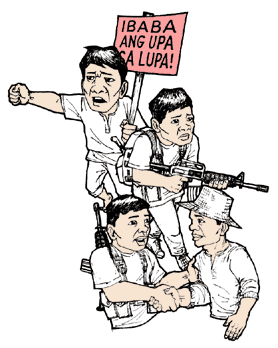
| Home | CPP | NPA | NDF | Ang Bayan | KR Online | Public Info | Publications | Kultura | Specials | Photos |

| |||||||||||||||||||||||
|
|
|
The Macapagal-Arroyo regime bragged about its supposed gains in implementing agrarian reform, on the occasion of the Comprehensive Agrarian Reform Program�s (CARP) 14th anniversary on June 10. It claimed to have exceeded by 4,261 hectares this year�s target distribution of 100,000 hectares of agricultural land set by Macapagal-Arroyo in her State of the Nation Address in 2001. It likewise claimed to have distributed the most number of Certificates of Land Ownership Award (CLOA) in a year in the entire history of CARP.  In truth, this is actually the lowest number of CLOAs distributed. Prior to this, the lowest figure was the 111,665 hectares that the Aquino regime claimed to have distributed during CARP�s first year. Neither were all of the lands that were supposed to have been distributed private lands: some 35,000 hectares of it was public land. Worse, such distribution was attended by a host of anomalies and deception. Among them are the;
The first three are all forms of alleged joint ventures between landlords and peasants. They are schemes through which big landlord-compradors are able to retain ownership and control over lands they are supposed to have distributed to farmers. In exchange, they give the farmers a few shares of the corporations or bogus cooperatives that are likewise controlled by the landlord-compradors. The VLT/DPS, which is now considered by the Macapagal-Arroyo regime as its strategy in the claimed implementation of CARP, is used as an instrument by landlords to transfer their lands to chosen "beneficiaries", often their children or relatives. The regime also uses this to bloat the number of persons supposedly given land under CARP. (See related article) Aside from this, landlords resort to so many other means long familiar to them to disregard, evade or reverse CARP�s implementation. From the beginning, CARP has purposely made room for many methods and loopholes to prevent the coverage of landlords� vast landholdings. In reality, CARP contains nothing but loopholes and embellishments, and its implementation has been replete with anomalies. Among them are;
CARP is no different from the various sham land reform schemes of the past: from Quezon�s vacuous "social justice" to Magsaysay�s decorative Land Reform Act (1955), Diosdado Macapagal�s bogus Agricultural Land Reform Code (1963) and Marcos� Presidential Decree 27 (1972). They all had the main objective of deceiving the farmers through illusory land distribution schemes, suppressing their resistance and keeping them shackled by feudal and semifeudal rule. None of them aimed to end landlord monopoly over vast tracts of land and distribute the latter for free to the farmers. If there ever was any land distributed, it was at very high amortization rates, far beyond what poor and middle peasants could afford. In the past three decades, the peasantry�s problem of having none or too little land to till has rapidly worsened. The bogus land reform programs of past and current regimes have not resolved the peasantry�s land problem; they have instead worsened it. As of now, seven out of 10 farmers do not have land of their own to till. Agricultural lands remain highly concentrated in the hands of big landlords, the comprador bourgeoisie and foreign agro-corporations. It is estimated that almost 20% of agricultural land in the country is owned by 9,500 big landlords, most of them comprador bourgeoisie as well. This is aside from even bigger landholdings effectively controlled by the big comprador bourgeoisie. Whether or not they directly own agricultural land, they are actually landlords of a new type. All of this proves that only agrarian revolution and armed revolution can solve the farmers� main problem of landlessness. The peasants who fight for land to till and to smash the old feudal and semifeudal system in the countryside and the rest of the country � they who join and support the New People�s Army and strongly uphold people�s war � are the main force for attaining genuine people�s democracy and national liberation. 
|
| ||||||||
|
[ HOME | CPP | NPA |NDF | Ang Bayan | KR Online |Public Info] [Publications | Specials | Kultura | Photos] The Philippine Revolution Web Central is maintained by the Information Bureau of the Communist Party of the Philippines. Click here to send your feedback. |
|